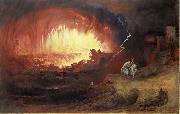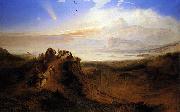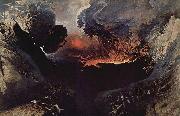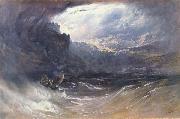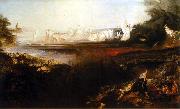John MartinBritish 1789-1854 John Martin Gallery | |||
 |
|||
|
|
|
||||||||||
|
|
||||||||||
|
The Destruction of Sodom and Gomorrah, Gemälde ID:: 59759 Siehe Galerie in Schweden |
The Destruction of Sodom and Gomorrah, The Destruction of Sodom and Gomorrah, 1852. The_Destruction_of_Sodom_and_Gomorrah,_1852. |
|||||||||
|
|
||||||||||
|
The Eve of the Deluge Gemälde ID:: 62815 Siehe Galerie in Schweden |
The Eve of the Deluge 1840 Oil on canvas, 143 x 218 cm Royal Collection, Windsor John Martin had humble beginnings in Newcastle-upon-Tyne as a herald painter to a coach-builder, and then in London as a painter on china and glass, but he later achieved a great success with his highly imaginative paintings of scenes from a variety of literary sources, particularly the Old Testament. Many of these pictures were executed on a vast scale and were frequently visionary in conception. The impact of Martin's paintings was also enhanced by his use of vivid contrasts in colour, which served to emphasise the grandeur and other-worldliness of his compositions, and the varying thickness of the paint surface. Apart from his paintings Martin was also a prolific illustrator and engraver, as well as a practising urban engineer. It was while Prince Albert was visiting Martin's studio that he saw one of the artist's major works, The Deluge (the second version of 1834, present whereabouts unknown), and suggested that the artist paint the related themes - The Eve of the Deluge and The Assuaging of the Waters - in order to make a series. It would seem, however, that the artist himself had already developed the idea for such a sequence. The subject of The Eve of the Deluge is ultimately based on Genesis 6:5-8, in which God despairs of man's wickedness on earth and decides to destroy him with the single exception of Noah. The figures on the promontory in the foreground are the patriarchs. The seated figure with a white beard is Methuselah, who is surrounded by the family of Noah. Methuselah instructs Noah to open the scroll written by his father, Enoch, so that he can compare the signs in the sky (sun, moon and comet) with those on the scroll. The fact that they match ordains the end of the world and this results in Methuselah's death. The figures hurrying up the slope include those described in the Bible as 'giants in the earth in those days'. In the middle distance, under the trees on the right, is a group of revellers representing the antediluvian age. Their behaviour has no doubt undermined God's confidence in man. Ravens, a symbol of ill omen, circle overhead. The ark, which Noah was instructed to build in order to save himself, his family and the animals, is visible on a distant promontory in the background on the right. Both The Eve of the Deluge and The Assuaging of the Waters were exhibited at the Royal Academy in 1840, and The Eve of the Deluge was acquired by Prince Albert the following year. The Assuaging of the Waters is now in San Francisco Museum of Fine Arts. Martin published his own account of these three paintings in a pamphlet entitled The Deluge of 1840. This shows that his sources were fairly recondite, extending beyond the historical and the religious to the cosmological and the eschatological, including Byron's Heaven and Earth. 'Altogether the three paintings amount to a history of the world, summarized in the terms of documentary mythology and dioramic episodes, compressed into three scenes - evening, 1840_Oil_on_canvas,_143_x_218_cm_Royal_Collection,_Windsor_John_Martin_had_humble_beginnings_in_Newcastle-upon-Tyne_as_a_herald_painter_to_a_coach-builder,_and_then_in_London_as_a_painter_on_china_and_glass,_but_he_later_achieved_a_great_success_with_his_highly_imaginative_paintings_of_scenes_from_a_variety_of_literary_sources,_particularly_the_Old_Testament._Many_of_these_pictures_were_executed_on_a_vast_scale_and_were_frequently_visionary_in_conception._The_impact_of_Martin's_paintings_was_also_enhanced_by_his_use_of_vivid_contrasts_in_colour,_which_served_to_emphasise_the_grandeur_and_other-worldliness_of_his_compositions,_and_the_varying_thickness_of_the_paint_surface._Apart_from_his_paintings_Martin_was_also_a_prolific_illustrator_and_engraver,_as_well_as_a_practising_urban_engineer._It_was_while_Prince_Albert_was_visiting_Martin's_studio_that_he_saw_one_of_the_artist's_major_works,_The_Deluge_(the_second_version_of_1834,_present_whereabouts_unknown),_and_suggested_that_the_artist_paint_the_related_themes_-_The_Eve_of_the_Deluge_and_The_Assuaging_of_the_Waters_-_in_order_to_make_a_series._It_would_seem,_however,_that_the_artist_himself_had_already_developed_the_idea_for_such_a_sequence._The_subject_of_The_Eve_of_the_Deluge_is_ultimately_based_on_Genesis_6:5-8,_in_which_God_despairs_of_man's_wickedness_on_earth_and_decides_to_destroy_him_with_the_single_exception_of_Noah._The_figures_on_the_promontory_in_the_foreground_are_the_patriarchs._The_seated_figure_with_a_white_beard_is_Methuselah,_who_is_surrounded_by_the_family_of_Noah._Methuselah_instructs_Noah_to_open_the_scroll_written_by_his_father,_Enoch,_so_that_he_can_compare_the_signs_in_the_sky_(sun,_moon_and_comet)_with_those_on_the_scroll._The_fact_that_they_match_ordains_the_end_of_the_world_and_this_results_in_Methuselah's_death._The_figures_hurrying_up_the_slope_include_those_described_in_the_Bible_as_'giants_in_the_earth_in_those_days'._In_the_middle_distance,_under_the_trees_on_the_right,_is_a_group_of_revellers_representing_the_antediluvian_age._Their_behaviour_has_no_doubt_undermined_God's_confidence_in_man._Ravens,_a_symbol_of_ill_omen,_circle_overhead._The_ark,_which_Noah_was_instructed_to_build_in_order_to_save_himself,_his_family_and_the_animals,_is_visible_on_a_distant_promontory_in_the_background_on_the_right._Both_The_Eve_of_the_Deluge_and_The_Assuaging_of_the_Waters_were_exhibited_at_the_Royal_Academy_in_1840,_and_The_Eve_of_the_Deluge_was_acquired_by_Prince_Albert_the_following_year._The_Assuaging_of_the_Waters_is_now_in_San_Francisco_Museum_of_Fine_Arts._Martin_published_his_own_account_of_these_three_paintings_in_a_pamphlet_entitled_The_Deluge_of_1840._This_shows_that_his_sources_were_fairly_recondite,_extending_beyond_the_historical_and_the_religious_to_the_cosmological_and_the_eschatological,_including_Byron's_Heaven_and_Earth._'Altogether_the_three_paintings_amount_to_a_history_of_the_world,_summarized_in_the_terms_of_documentary_mythology_and_dioramic_episodes,_compressed_into_three_scenes_-_evening, |
|||||||||
|
|
||||||||||
|
Der grobe Tag des gottlichen Zorns Gemälde ID:: 66582 Siehe Galerie in Schweden |
Der grobe Tag des gottlichen Zorns c. 1853 Oil on canvas 196,5 ?? 303 cm c._1853 Oil_on_canvas 196,5_??_303_cm |
|||||||||
|
|
||||||||||
|
The Deluge Gemälde ID:: 67008 Siehe Galerie in Schweden |
The Deluge 1834 Oil on canvas 66 x 102 inches 1834 Oil_on_canvas 66_x_102_inches |
|||||||||
|
|
||||||||||
|
The Last Judgement Gemälde ID:: 67009 Siehe Galerie in Schweden |
The Last Judgement 1853 Oil on canvas 1968 x 3258 mm 1853 Oil_on_canvas 1968_x_3258_mm |
|||||||||
|
|
||||||||||
| Vorheriger Künstler Nächster Künstler | ||||||||||
|
|
||||||||||
| John Martin | ||||||||||
| British 1789-1854 John Martin Gallery | ||||||||||
|
|
||||||||||
IntoFineArt Co,.Ltd.







